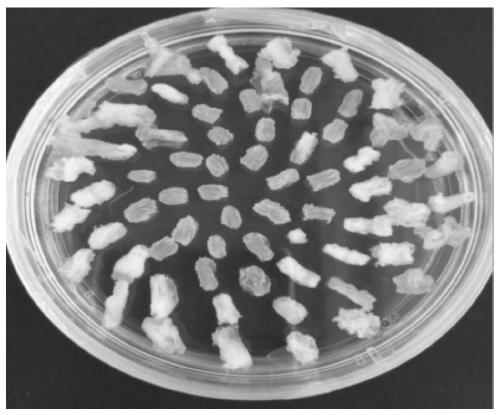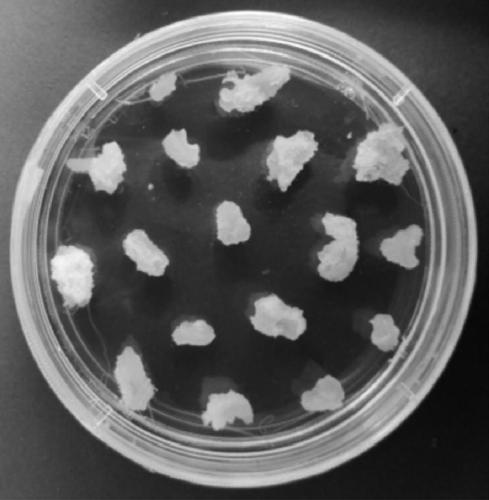Preparation method and transformation method of papaya hypocotyledonary axis agrobacterium transformation receptor
A technology of Agrobacterium transformation and papaya, which is applied in the field of plant genetic engineering, can solve the problems of not particularly stable system, long callus induction period, and restricting the development of papaya breeding industry, etc., to achieve simple and efficient medium and simple operation Ease of operation, avoiding the effect of multiplication time
- Summary
- Abstract
- Description
- Claims
- Application Information
AI Technical Summary
Problems solved by technology
Method used
Image
Examples
Embodiment 1
[0037] A kind of preparation method of papaya Agrobacterium transformation receptor
[0038] Include the following steps:
[0039] (1) Seed disinfection: take 150-200 papaya seeds and place them in a sterilized tissue culture bottle, ①, disinfect with alcohol with a volume concentration of 75% for 1 min, and wash with sterile water for 3-5 times, ②, enter a volume concentration of Disinfect with 3.5% NaClO solution for 20 minutes, wash with sterile water for 3 to 5 times, ③, transfer to mercuric chloride with a mass concentration of 0.1% for 10 minutes, wash with sterile water for 3 to 5 times, ④, use sterile tweezers Put it into a sterilized Erlenmeyer flask, add 100ml of NaClO solution with a volume concentration of 20%, and put it in a shaker at 28°C and 180rpm for 4h; this process is all performed on a clean bench.
[0040] (2) 1M KNO3 treatment: take the seeds obtained in step (1), take them out from the 20% NaClO solution, wash them with sterile water for 3 to 5 times, re...
Embodiment 2
[0050] Target gene vector construction
[0051] The recombinant vector containing the 35s-CpYh-1 target gene is constructed according to the method comprising the following steps: using the cDNA of SunUp variety papaya as a template, using primers 35s-CpYh-1F and 35s-CpYh-1R to carry out PCR amplification, and The 735bp fragment of the amplified product (such as Figure 6 shown) was inserted between the M13 universal primers of the plasmid pMC202 (purchased from the ABRC official website) vector by homologous recombination to obtain the recombinant vector pMC202-35s-CpYh-1, and the primers HYG-F / R and primer 35s for the recombinant vector -CpYh-1F / R amplification confirms that the vector is constructed successfully (such as Figure 7 shown).
[0052] The nucleotide sequence of the target gene 35s-CpYh-1 is shown in SEQ ID NO.01:
[0053] ATGGAGTTTGAGGATCAAGATGAGCAAGATGAAGAGATGGGAATGGGAACTGGTTGTGGGTCACTCCGTAACTCGACCGGGGTCAAACTGGGCGGTCCGAAGGCTGTGGGGACGGGGACAGGGACGGATCATCGGCAG...
Embodiment 3
[0061] An Agrobacterium-mediated transformation method using the above-mentioned papaya hypocotyl Agrobacterium transformation receptor
[0062] Include the following steps:
[0063] 1. Infection: adjust the OD value of the Agrobacterium infection solution containing the target gene suspended in 1 / 2 MS liquid medium to 0.5-0.8, and then dilute it 10 times to obtain the prepared infection solution. The papaya hypocotyl section obtained by the above preparation method can be soaked in the infection solution for about 8 minutes, the supernatant is poured off, blotted dry with filter paper, and blown until the surface of the hypocotyl section is dry, and can not be blown for too long. (Cell division is more severe after five days of pre-cultivation, so the infection is done directly in a sterile petri dish).
[0064] 2. Co-cultivation: place the hypocotyls infected in step (1) on k4 medium and add sterile filter paper to co-culture for 24 hours, and dry the co-cultured hypocotyls...
PUM
| Property | Measurement | Unit |
|---|---|---|
| concentration | aaaaa | aaaaa |
Abstract
Description
Claims
Application Information
 Login to View More
Login to View More - R&D
- Intellectual Property
- Life Sciences
- Materials
- Tech Scout
- Unparalleled Data Quality
- Higher Quality Content
- 60% Fewer Hallucinations
Browse by: Latest US Patents, China's latest patents, Technical Efficacy Thesaurus, Application Domain, Technology Topic, Popular Technical Reports.
© 2025 PatSnap. All rights reserved.Legal|Privacy policy|Modern Slavery Act Transparency Statement|Sitemap|About US| Contact US: help@patsnap.com



